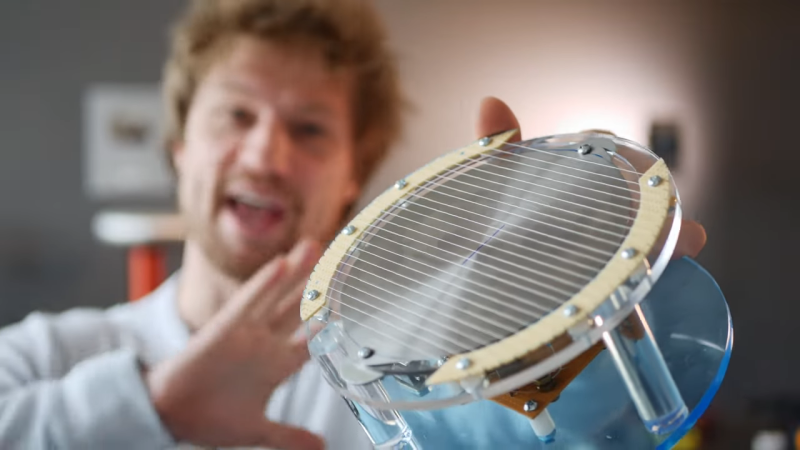Depending on the context of the situation, the staccato clicks or chirps of a Geiger counter can be either comforting or alarming. But each pip is only an abstraction, an aural indication of when a particle or ray of ionizing radiation passed through a detector. Knowing where that happened might be important, too, under the right circumstances.
While this plasma radiation detector is designed more as a demonstration, it does a pretty good job at localizing where ionization events are happening. Designed and built by [Jay Bowles], the detector is actually pretty simple. Since [Jay] is the type of fellow with plenty of spare high-voltage power supplies lying around, he took a 6 kV flyback supply from an old build and used it here. The detector consists of a steel disk underneath a network of fine wires. Perched atop a frame of acrylic and powered by a 9 V battery, the circuit puts high-voltage across the plate and the wires. After a substantial amount of tweaking, [Jay] got it adjusted so that passing alpha particles from a sample of americium-241 left an ionization trail between the conductors, leading to a miniature lightning bolt.
In the video below, the detector sounds very similar to a Geiger counter, but with the added benefit of a built-in light show. We like the way it looks and works, although we’d perhaps advise a little more caution to anyone disassembling a smoke detector. Especially if you’re taking apart Soviet-era smoke alarms — you might get more than you bargained for.
















The context of the situation probably likely depends of the setting of the setup.
A smart person would never touch an alpha emitter. I had a teacher who was notoriously careless with stuff like that. She got cancer in her fingers.
Generally speaking I’m with you:
You should avoid every exposure you can avoid, especially with alpha and beta radiation since it’s more energetic and easier to block. This is also true for gamma radiation, although it is harder to block.
In this case I guess it won’t be that bad for [Jay Bowles] as he may only have touched it once.
Chances for cancer in his finger are now higher than before but not as bad as it was with your teacher.
Anyway stay safe whatever you do and reduce every risk that is possible.
Here is a good one. http://www.hep.ph.bham.ac.uk/general/outreach/SparkChamber2/
Hi, I’d like to see you try a 3d volume detector, but I don’t think it can work. In fact I’m not sure what you expect to see. If you could get the voltages correct… The alphas always start ionising straight out of the source, so you won’t get any that trigger in the middle of your volume but not the entrance area. Maybe you’re thinking that if they enter at an oblique angle you’ll see that. Again I don’t think you will: if a spark occurs in the top layer, it will probably trigger a spark right under itself in the next layer. So I THINK all your sparks will run vertically down from the entry point. Anyway, good luck.
PS you might prefer to build a proportional counter, which is very similar to your spark gap detector, basically you just need a different gas and lower voltage and thinnest possible wire. The benefit is that you can discriminate different types of radiation. But you don’t get the nice light show.
Just connect each wire with very high value resistor and make sure it has enough capacitance to make visible spark. That way one discharge in top layer will not discharge wires in middle, which means that single particle can cause several discharges troughout the system.
Lots of ways to count cosmic rays/particles. Optical spark chambers (pretty sparks but much larger volume) that I’ve seen took photos from above and to the side when triggered in order to get location info. Chamber planes were foil, not wire, and had multiple gaps.
At Fermi we had spark chambers measuring ~3’x6′ (or larger) several x-y planes deep. They still sparked, but the readout was magnetostrictive.
Proportional counters aren’t that impressive, but (unlike spark chambers) you can measure energy deposition. You need to instrument every wire though. they tended to be much smaller.
Most of these depended on some sort of trigger- usually a photomultiplier/scintillator ‘telescope’. For the large spark chambers, high voltage was pulsed when a trigger signal was received. All very impressive…
I guess what you mean with a 3D detector is a Spark Chamber. You can find pictures of them online. They are a somewhat common exhibit at particle physics institutes.
I know where the radiation is. It’s in the fruit bowl in the kitchen. There’s also a suspicious tritium light (made with a bunch of vials) on a shelf in the lounge.
The only use I’d have for a radiation detector is to see which of the wife or daughter has been eating the most bananas (or tritium vials).
While a Geiger counter can’t generally pick up the seriously low energy from tritium decay, especially after zipping through a glass vial – a sensitive gamma spec with a berillium window can though. While I can’t remember the flux, a plastic encased glass vial of tritium gave a nice clear signal. Quite sufficient to dissuade from keeping one in a pocket on a key chain for years.
Or, you could build a cloud chamber.
https://en.wikipedia.org/wiki/Cloud_chamber
I wish the video had gone into any detail on how he tuned it to react just to radiation. He glosses over the tuning step but clearly states that it was really important.